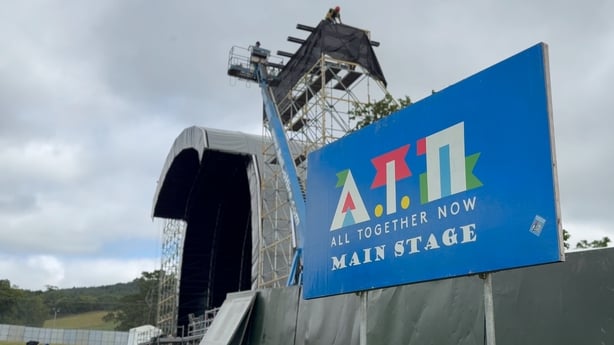The arts and music festivals come thick and fast at this time of year.
This weekend we have All Together Now – following on from Longitude just a couple of weeks ago.
And they come after the likes of Forbidden Fruit, Beyond the Pale, Kalidescope – with Another Love Story, Body and Soul and Electric Picnic yet to come (not mentioning the countless other music and artists festivals that take place across the country).
And they’re an expensive to attend. Tickets for the (sold out) All Together Now started at €250, Longitude was €200 – though there’s no camping available for that. Electric Picnic tickets were closer to €300.
And if you were going as a couple – or even with your entire family – that’s going to add up quite quickly. And that’s before you factor in the transport costs, and the cost of food and drink for the weekend.
You could very quickly find yourself in the ‘foreign holiday’ realm of spending – and that’s assuming you’re just going to one festival and not multiple events.
It’s a far cry from the good old days of Lisdoonvarna and Féile…
We need your consent to load this rte-player contentWe use rte-player to manage extra content that can set cookies on your device and collect data about your activity. Please review their details and accept them to load the content.Manage Preferences
Yes – from time to time sometimes see ticket stubs and posters for old gigs and festivals doing the rounds online and people always hone in on just how cheap the tickets were back then.
At the first Lisdoonvarna in 1978, for example, a weekend ticket was a whopping £5. That would be the equivalent of around €37 today.
Although things had picked up a good bit by the first Féile in 1990 – it would have been held this weekend 35 years ago. A three day weekend ticket to that was just under £30 – which is equivalent to €80 in today’s money.
So even in that decade or so you can see things getting much more expensive, but even that would still be considered startlingly good value for a three day festival nowadays.
Bar the fact that everything is more expensive nowadays – why are festival tickets so much dearer?

The first thing we need to do here is recognise our own part in the problem.
Because the reality is that consumer tastes and expectations have changed dramatically since the late ‘70s – and even early ‘90s, when compared with today.
The likes of Lisdoonvarna and the Trip to Tipp might be the stuff of legend – but I don’t think they’d pass muster with gig-goers nowadays.
For a start the line-ups were almost exclusively local acts.
Lisdoonvarna was all Irish trad, while the only international act at Féile 1990 was Meatloaf.
There’s nothing wrong with that – but at the same tie there’s definitely an expectation nowadays that a premium music festival has to have at least a few big, internationally-popular acts in the line-up.
That doesn’t mean they can’t be Irish – among All Together Now’s headliners are Fontaines DC and CMAT, while Electric Picnic has Hozier. But they sit next to global stars like Chapell Roan and Nelly Furtado; and wherever they’re from those big-name acts are going to cost more to secure.
Gig-goers today also have a higher expectation around the look and sound of the acts. You’d probably be foolish to go to a festival purely for the sound quality, but you do expect it to sound somewhat decent.
And we expect festivals to have multiple stages as well as the likes of comedy tents, chill out zones, wellness areas and even activities for kids.
And it’s not just the entertainment where our expectations are higher – it’s the facilities too. It’s fair to say that Lisdoonvarna and even Féile would have been a much more ‘informal’ affair than what you’d get at a festival nowadays.
Of course there would have been toilets and food and drink – and maybe camping – but it would have been fairly minimal stuff.
You’re talking ham sandwiches and maybe a burger and chips… compared to a wide variety of food and drink options now, catering to all kinds of tastes and diets.
And that’s not all driven by consumer demand – the legal requirements on festival organisers has also changed a lot, even since the 1990s. It’s no longer good enough to pick a large field somewhere, cobble together a stage, and then start selling tickets. Because there are now significant health and safety requirements around holding public events.
You need adequate numbers of toilets based on the number of attendees, for example, you need to have proper walkways for people to safely get around, you need good lighting on those walkways – you need to have a traffic and crowd management plan for people coming to and from the event, you must have adequate security. And of course all of these facilities – especially the stages – have to be built to a very high standard to ensure won’t collapse or cause injury in some other way.
Insurance is often cited as a big factor in the high price of Irish gig tickets, isn’t it?

This is a common refrain from some promoters defending high ticket prices in Ireland.
Back in 2023 Peter Aiken of Aiken Promotions blamed insurance costs in Ireland when he was defending the high price being charged by Bruce Springsteen for his RDS shows that year.
As an example, he said Ed Sheeran’s 2022 gigs in Cork had cost €65,000 to insure – compared to just €1,500 for his show in Belfast.
Similarly he said a Rod Stewart gig in Belfast had cost just over £200 to insure – but his Dublin show cost €10,000.
But those in the insurance industry say the cost of cover is not nearly as big of a factor as some would suggest. Generally, they say, you’re talking less than a euro per ticket sold – at least for basic public liability insurance.
In the context of an organiser probably having to pay out tens of thousands of euro if a festival goer falls and breaks an arm or leg, that’s not a lot.
And that’s clear even if you take Peter Aiken’s Rod Stewart example. At €10,000 for a gig in 3Arena, which holds between 9,300 and 13,000 people depending on the configuration, you’re still talking about – at most – a cost of €1.07 per ticket sold.
And how is the insurance cost calculated for something like a festival?

According to Jane Brady of Brady Insurance, which specialises in insuring events from small village fairs to the St Patrick’s Day festival, there are two main factors that influence the cost of event insurance.
One is, obviously enough, the number of people who will be attending the event; because the rate would be X amount per person.
The other factor is the venue. The big variable there is whether it’s a permanent venue – like an arena or a concert hall, or whether it’s in a temporary, outdoor venue – as most big summer festivals tend to be.
And this is where all of those facilities – like walkways, lighting, toilets and so on, come into the mix. Jane said an insurer would want to know that festivals have a thorough event plan in place – and are prepared for as many eventualities as possible – as part of their cover.
And she said having a track record helps a lot here – if this is your 10th time organising an event like this, and they’ve all run smoothly in the past, you’ve shown that you know what you’re doing. Whereas there’s obviously a higher risk involved if it’s someone who’s holding an event like this for the first time ever.
And that’s all taken into account for public liability insurance.
Another optional extra that festival organisers might take out – that would add to the cost – is cancelation cover, which means they can get back most of their costs if they have to cancel due to the likes of bad weather, or if an act pulls out at the last minute.
And does the type of acts taking part in the festival have an impact?

Yes actually – insurance underwriters would treat certain types of music differently to others, for example.
So if you’re a festival that specialises in something that’s a bit more ‘energetic’ like metal or EDM – you’re probably going to be seen as riskier than the average.
On the other hand, if you’re looking for insurance for a choral music festival, there’s probably not too much concern on the insurer’s part that someone is going to get injured in the mosh pit.
But the type of act can influence the insurance cost in a different way. For example an act that has a reputation for not turning up to perform would naturally have a higher risk rating when it comes to cancellation cover.
But an older act might carry a heavier risk burden too – because there’s a greater potential for them to get sick, or injured, or lose their voice. That’s especially true if they have a heavy tour schedule, and they’re not building in plenty of breaks and days off between shows.
This summer we saw one festival – Beyond the Pale – have a bit of a wobble where it looked at the last minute like it might not go ahead. They blamed cashflow issues – and did manage to fix the problem… but would something like that be covered by insurance?

No, cancellation cover would protect you against something else that was out of your control. Not having the money to hand to cover costs would be seen as something that the organiser would be across.
But that highlights one of the other key issues that can make a festival so expensive – because it’s a high risk venture, especially for the newer festivals that aren’t guaranteed to sell out immediately in the way that the likes of Electric Picnic does.
The planning on a festival starts a year or more before it takes place, and the initial line-up usually gets announced around nine months ahead of time in order to drum up ticket sales.
That means those acts have to be secured long before money starts to pour in – while you will also have to start handing over deposits and payments for other things like the venue, the staging and facilities, as well as getting together the crew that can make it all happen.
It’s kind of a ‘build it and hope they’ll come’ situation.
And this is part of the reason why corporate sponsors have become so important to festivals of all sizes – because you can get them on board relatively early, and get some revenue from them to help cover those inital, upfront costs.
So while people may dislike how branded and corporate music festivals have become – and they perhaps yearn for more festivals like Glastonbury or the Woodstocks and Lisdoonvarnas of old – the reality is that, without those brands, a lot of these events simply would not happen in the first place.




